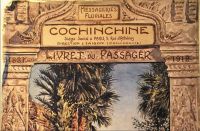
Uncertain origins
The history of the Messageries takes us back to the 1870s, at a time when the French admiralty was supporting about three thousand troops in Cochinchina and when the Saigon port, then a little over fifty thousand inhabitants, was hosting the Colonial Council, which, before the time of Governor General Paul Doumer, was levying taxes from the indigenous population and employing them in a discretionary fashion. That is also to say, if you wanted to set up a trade in those times, you needed a real spirit of adventure and a strong will, or much political clout in this small pond.
Uncertain origins
The origin of the Messageries Fluviales de Cochinchine, the River Shipping Company of Cochinchina, depends on who tells the story.
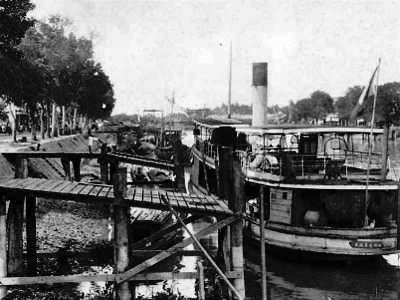
A steamer ready to depart from Mỹ Tho and head West towards the Mekong Delta. Image ©
Belle Indochine
The famous Roque brothers, Victor and Henri, who came from the province of Aveyron, in France1) but who had already been is Asia for awhile, were supplying the Cochinchina troops from the Philippines since 1857, and more so since the landing in Tourane2) in 1858. When the Admiralty called on private entrepreneurs to take part in the construction of the colony with the help of subsidies levied from the Indochinese population, Victor came and settled in Saigon in 1860, then had his brother Henri come along, and they partnered in 1870 with a Mr. Marcellin Larrieu to open the Steamer Shipping Company of Cochinchina3), which started trading the rivers between Saigon and Cambodia, at the time up to Kratie, the hightest point deemed navigable on the Mekong.
Several years later, after the failure of a project in railways, already towards Cambodia, Jules Rueff4) turned to the river, a much more natural communication way in the region, and founded the River Shipping Company of Cochinchina (Messageries Fluviales de Cochinchine) in 18815). The Messageries, the head office of which was in Paris, were from the start endowed with the largest capital in the colony (one and a half million francs), and were allocated since even before incorporation the subsidies that had been until then given to the Steamer Shipping Company, and a nine-year-contract ensuring the monopoly over mail shipping6). They took the upper hand on river transportation towards the Mekong delta and Cambodia.
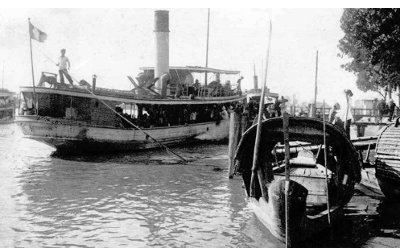
The Roque brothers are often credited with the foundation of the Messageries Fluviales, although the statutes of the Messageries give its origin in 1881. Was it a common agreement? Did one of the Roque brothers come back to establish the Messageries with Rueff7)? Was it an example of the discretionary power the Colonial Council exerted in the wielding of its subsidies? The jungle never stopped at the entrance of the city.
Anyhow, many companies could envision their success only with the help of subsidies, and the granting of such subsidies often made for an uneven playing field. We could find no hint of the Steamer Shipping Company after 1882, and we meet the Roque brothers again far North in Tonkin as soon as a few years afterwards.
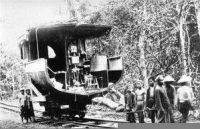
a time for adventure
The Messageries fluviales took a central part in the logistics of the 1893 expeditions upstream to Laos, with launches like the Hàm Luông, Lagrandière, or Massie, which allowed access up to Luang Prabang and even to the Golden Triangle and the Southernmost confines of China. But at that time, like today, the Khôn falls, at the 4000 islands, prevented steamers from crossing the Mekong upwards from Cambodia to Laos. In order to transport the first launches to the first bief upstream, the Messageries installed on the large Khôn island first a metric railway with three hand-powered carts, then a real railway when commercial traffic took up.
A time for adventure
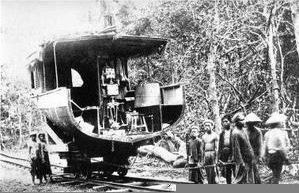
To take her upstream, the launch Hàm Luông, was truncated and set on rails on the South of Khôn island in October 1893, then hauled towards Laos on a man-powered cart. Branded a gunboat, she displaced only 20 tons. (Image ©
Souvenir Français de Chine)
There we find a steamer named Bassac, shuttling goods between the Southern end of the Khôn island, just South of Laos, and Cochinchina.
Like many de facto monopolies, the Messageries Fluviales had a mixed reputation of using and sometimes abusing their privileged position. Supplying the troops and colonization effort towards Tonkin was very lucrative, and it was probably to keep the upper hand on this market that the Messageries Fluviales supported and even financed in part the 1893 expeditions, meant to open commercial routes to Laos.
When they opened a line towards Battambang, which was de facto under the dominion of the kingdom of Siam (now Thailand) but was coveted by France, the Messageries ran along this way very irregularly. Traders who needed to ship goods through the Battambang would have to pay grossly inflated fares and even kickbacks, and it is said Jules Rueff would lend at the steep rate of 120% per annum8). When competitors tried to open trading routes on waterways Rueff judged his own, not only did they not get the subsidies, but the Messageries had their own contracts extended.9)10)
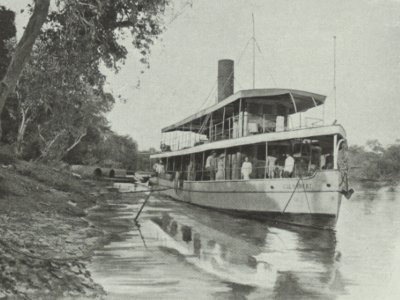
The Colombert, a 105 tons steamer, in Laos; in:
Excursions aux temples d'Angkor; livret du passager, published by the
Messageries Fluviales de Cochinchine, 1912. Image ©
South East Asia Visions
“In this business, which was entirely to the benefit of the Company, the Colony was to pay for the whole 25 years of the contract that committed it to Rueff, as a postal subsidy, considerable amounts of money, which allowed him to build within 15 years
11) a colossal fortune. […] That did not prevent the management from being such misers as to make all the Scroodges on Earth pale in jealousy.”
12))
The crew were ill-paid and made liable for any loss, but such was the moral standing that some had a reputation for good living, and a few even made a fortune, basking in riches, women and even racing horses, like a certain Commissioner P… on board the steamer Donaï13), who the tax officers chased all around Indochina and Siam for smuggling weapons and opium but never caught.14)
The Messageries Fluviales were nevertheless very present throughout the period, and took an active part in the expansion of the colony. Its boats were involved in both the logistics and the military operations, the cargo J-B Say was even sunk by the Siamese in 189315)) in the midst of such an operation.
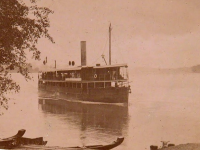
Power and neglect
The adventure and passion for the river must have dwindled with the advent of the later contracts: in 1914, no question of a 20-years monopoly anymore, and the terms were tightened so much as to turn the Messageries essentially into an administration.16) Between the ebb and flow of the Mekong, the lack of diligence of the officers in charge and insufficient infrastructures, The Messageries, went on neglecting their duties until the outrage flared in the late 20s.
Power and neglect
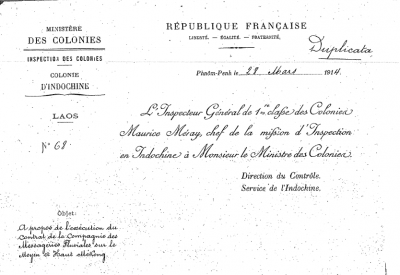
The beautiful
report to the Minister that paved the way to the tightening of the Messageries's contract. It speaks of slack, of missed connections, and of lack of enthousiasm. There again we hear of the
steamer named Bassac, trading in 1914 between Phnom Penh and Kratie.
PDF, in French, (c) Kyoto University
About a paved road along Khôn island, built less than 10 years before: “M. le Résident Supérieur p.i. en marge du rapport sur la province de Bassac: Il est certain que c'est l'esprit de suite qui a le plus manqué au Laos. Il semble que les routes faites aient cessé d'intéresser M. Mahé -et c'est ici le cas- dès l'instant où elles étaient terminées. Aujourd'hui la chaussée est envahie par l'herbe, les ponts sont effondrés et la machine complètement rouillée sera très difficile à remettre en état.”
Mr. the interim Superior Resident in the margin of the report on the province of Bassac: Surely the spirit of continuity is what lacked most in Laos. It seems that roads, once built, ceased being of interest to Mr. Mahé -and this is the case here- as soon as they were complete. Today the pavement is overgrown with weeds, the bridges have collapsed and the rusted out engine is going to be very hard to put back in order.“
Then the Compagnie Saïgonnaise de Navigation et de Transport (C.S.N.T.)17) and based in Saigon, the Messageries steeply increased the river transportation fares in 1926, once the contracts had been secured for a new period, thus opening wide the way for Siamese (Thai) competition, anchoring their bad name with the residents of Laos, and firing outrage in the metropole.
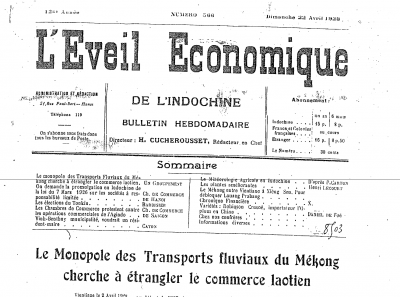
The
indictment by the Laotian business society of the acts of the C.S.N.T in 1928, in
Economic Awakening. “The river transport monopoly is trying to strangle Laotian trade”
PDF, in French, (c) University of Kyoto
The business became essentially a conglomerate: the capital of the Messageries was invested into as diverse sectors as plantation and transformation of rubber, the Comptoirs Généraux de l'Indochine (general commercial venture, state-sponsored), public works and electricity, sawmills and the Crédit Foncier de l'Indochine, a bank.18)
The C.N.S.T. was eventually sold in 1938 to the Société de Chalandage et Remorquage de l’Indochine (River shipping and Tugging company of Indochina).
a steamer named Bassac
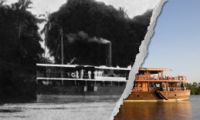
A steamer named Bassac was already trading the Mekong in the 19th Century
The story of the River Shipping Company of Cochinchina had ups and downs and more or less moral times, but one thing they had right: Their boats were well adapted to their missions, for the better part. If the early launches to Laos were quick for that time, light enough to carry through Khône, those that navigated the lower Mekong were as well fit for that area.
When the Messageries had to establish a line to Khôn, their current First Class Steamboats were not fast enough to run upstream in the high waters season, so here comes the unclassed river steamship Bassac, the first cabin cruiser to be able to run all the way up the Mekong to the North of Cambodia, and host passengers at night when needed.
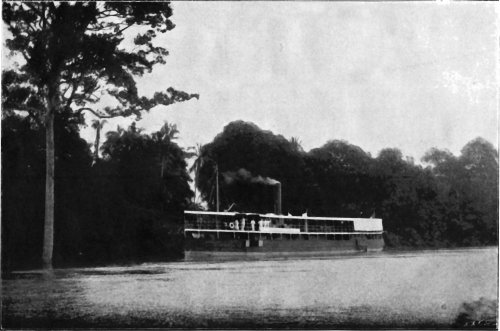
the first of the
Bassac, at an anchor near a cây sao tree in a flood. Image ©
ANAI
The Bassac makes a class apart, able to run 12 kts (about 20km/h on still water), as fast or faster than the Second class (daytime) launches that were used along that route until then. She was employed from the early 1890s on between Châu Đốc, Phnom Penh and the Southern station on the island of Khôn, where she once hosted Governor General Paul Doumer. From July 1896 on, she ran the line with a new sister ship, the Vien Chan.19)
Her tall, straight bow and high free-board suggest the first Bassac could have been designed to reach Saigon through rạch nước mạn, which shows sea swell.
The Bassac was fitted with electrical ventilation only in 1914 and on a pointed order by the General Government of Indochina on the exclusive contract for postal service, which left little to interpretation by the Messageries20).
Some choices remain up-to-date
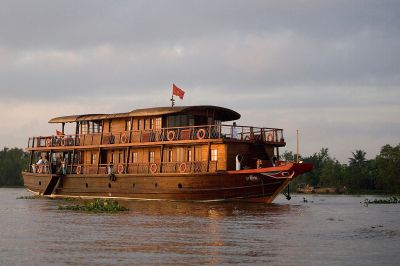
More than a hundred years later, the dimensions of the boats remain dictated by the rivers they trade, even with the additional constraint of crossing bridges that were not there at the time. Today's Bassac follow many choices made by the pioneers of the XIXth Century, in capacity, dimensions and speed, even though we did not know the XIXth Century Bassac when we designed and built ours.
Today as then, to be able to turn around and stop anywhere on these waterways, we still need to be less than 40 meters in length. The secondary canals and rivers, like Chợ Lách Canal, get very narrow in the low waters, and we may need to stop at a moment's notice if debris or a tree then, or a sand barge today, is in the way. And if we go along with the current, it means turning around and casting anchor.
Today's Bassac's air draft meets the same constraints as in the XIXth Century: in case of a strong wind, and a sudden gust may come in a moment in the monsoon season, we must be low enough on the water to ensure stability, and if necessary get some cover from the vegetation. As they do not have the large bulk of a steam engine, with its boiler and coke store, to weigh them down and stabilize them, our Bassac are wider than the historical steamer.
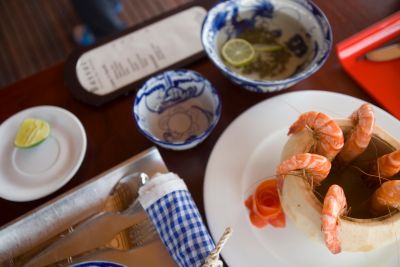
Some standards, we needed to update
“
At Rueff's, the dining table and on-board hygiene remained to the end very inadequate and it was not until 1910 that, with the expiry of its contracts looming, the Company grudgingly consented to add 4 poor cabins […]
and at last equip the steamers with such a pale electric light that the passengers had to give up any reading after dark.”
21)
Fortunately, today's Bassac do not blindly follow all the standards set forth by our glorious forefathers. Today, no need for a candle on the half-deck, near the horses and poultry, to get to read at night.
















